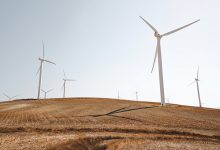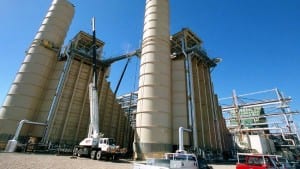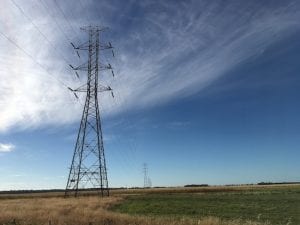The Australian Energy Regulator (AER) has put forward default market offers (DMO) for retail electricity price rises for the fiscal year starting 1 July 2023 of +20-25% for New South Wales, Queensland and South Australia, while Victoria will see 25% increases. This is largely consistent with the draft proposals put forward in March 2023.
It is important to note that the expected electricity price rises in the AER’s DMO are about half the hike that might have happened without the Albanese federal government’s timely and critical intervention to cap wholesale fossil fuel prices at the end of last year (see figure below), and provide cost-of-living support in the May 2023 budget to offset some of this pressure.
We expect that this could well be the peak in absolute electricity and gas prices at the retail level. There is a massive lag in the system in passing through the 2022 hyperinflation of fossil fuel commodity prices, which in turn squeezed up electricity prices to record Australian highs.
Even with slow rises in grid transmission and distribution costs per capita as Australia implements the grid expansion and modernisation program (supported by the $20 billion Rewiring the Nation and implementation of the investment to enable the massive new Renewable Energy Zones and grid firming, e.g. the now exceptionally expensive and much delayed Snowy 2.0) retail prices should decline from July 2024 onwards.
The global LNG and coal prices hit unprecedented new peaks in 2022, but have since the start of 2023 come down significantly, with both thermal and coking coal prices down another 10-20% in recent weeks.
Thermal coal prices (Newcastle 6,000kcal NAR export grade) surged from US$50/t in 2021 to a record high US$440/t in 2022, but have now fallen to US$160/t.
Meanwhile, Asian spot LNG fell below US$10/mmBtu this month, down more than 75% from its peak of a year ago, and nearly equal to the A$12 east coast domestic price cap Minister Bowen implemented to reduce the multinational gas cartel gouging that was well underway.
Climate Energy Finance estimates Australian fossil fuel exporters made over $A150 billion gross profit in 2022/23, and that the timid $A600 million per annum increase in the PRRT needs to be revisited to ensure war profiteering at least provides some material contribution to the cost of living pressures inflicted on the average Australian household and industrial customers.
It is really important for Australian consumers to understand that unlike inflationary fossil fuels, renewables will prove to be progressively deflationary, even including firming costs.
For example, we expect solar module prices to decline by 10% per year over the rest of this decade, re-engaging the decade long trend seen since 2010.
A halving of installed solar costs by 2030 will accelerate the energy transition and progressively unwind the fossil fuel cost of living crisis inflicted in 2022/23, and create a medium term deflationary tailwind to offset the rising interest rate cycle hitting households in 2023.
The 20-30% decline in solar module prices out of China year-to-date 2023 and the massive 294 gigawatts (GW) of solar module manufacturing capacity adds seen in China and India in the first quarter of 2023 alone (according to the new technology manufacturing report by the IEA), will flood the world with new annual solar supply at double the global solar install rates seen only 1-2 years ago.
And the US Inflation Reduction Act is mobilising investment capital to increase US solar module manufacturing capacity sixfold to 40-50GW annually as well, whilst India’s solar Performance Linked Incentives are likewise bringing a threefold increase in Indian solar manufacturing capacity to 40-50GW pa as well. bringing increased supply chain diversification. This is a really positive medium-term trend.
As an interim measure to moderate price pain, the government has confirmed in the 2023/24 federal budget a responsible, noninflationary bill relief package worth a total of $3 billion including contributions from its state counterparts.
In NSW, Queensland, SA and Tasmania, the total bill relief will be $500 per eligible household; in Victoria, $250 plus a one off $250 direct payment through that state’s Power Saving Bonus; in WA and the NT, $350; and in the ACT, $175 per household, with the ACT’s Large-scale Feed-in Tariff already lowering the average bill by ~$150, brilliantly showcasing the deflationary power of renewable energy.
Electrification and energy efficiency are also key to reducing bills, and this year’s budget included $314 millio tax relief Small Business Energy Incentive for investments in energy-efficient equipment of SME businesses via a tax deduction of up to $20,000.
A further $1 billion in the massively expanded low-interest loan program to be administered by the Clean Energy Finance Corporation (CEFC) (in partnership with private banks) for home building energy efficiency upgrades, gives a financial boost to insulate households from future energy price shocks.
A further $300 million budget allocation funds energy performance upgrades on 60,000 social housing properties. And $37 million is allocated to modernise our energy efficiency standards, including the exceptionally important and long overdue expansion of the Nationwide House Energy Rating Scheme (NatHERS) to cover existing homes as well as new builds, creating an energy efficiency star rating system that will help Australians make the best choices when it comes to renting, purchasing, or renovating houses. This is a key priority CEF has been calling for to permanently reduce energy cost of living pressures.
Together with the wholesale price caps, these measures are a signature of a government acting in the interests of everyday Australians as we transition to a zero-emissions grid.
The only solution to permanently lower power prices and alleviate associated cost of living pressures is to decouple our economy from polluting, inflationary fossil fuels and accelerate the transition to cheap, clean firmed renewable energy.
While wind and solar are intermittent, they have a zero marginal cost of generation once built, and so they drive wholesale price reductions and the increased ‘duck curve’ volatility provides the real time arbitrage price incentive for the battery and pumped hydro storage firming capacity required.
We would encourage the rapid commencement of the rollout of the federal government’s Capacity Investment Scheme to reduce financing costs and crowd-in private capital into firming infrastructure, particularly in light of the ongoing Snowy 2.0 debacle.
CEF calls for board accountability at Snowy Hydro. Its $10-15 billion total cost is a straight-up massive new tax on consumers thanks to the incompetence of the previous government and this board.
CEF would also remind the Australian government that this is a global technology and investment race. We are blessed with world-leading natural resources – including the world’s leading supply of lithium and abundant reserves of other critical clean energy inputs – as well as wind, solar and land, but China has a decade’s head start, and is still accelerating, with 86% of its new electricity capacity installs year-to-date 2023 being zero emissions.
China in the first quarter of 2023 became the world’s largest EV export nation, overtaking both Japan and Germany in recent months. In this geopolitical context, the new US-Australia Compact highlights the massive value-added mining opportunities for Australia as we export ‘embodied decarbonisation’ in the green metals and minerals that underpin the global energy transition, whilst adding diversity to global supply chains.
Australia is perfectly positioned to leverage its abundant renewable and critical minerals resources and seize the once in a hundred-year opportunity to establish itself as a new world economy superpower, reaping the enormous benefits this will bring for Australians, domestic and business energy consumers alike, as well as for investment, trade, jobs and exports.
Tim Buckley is director of Climate Energy Finance. Contributing editor Annemarie Jonson [email protected]










